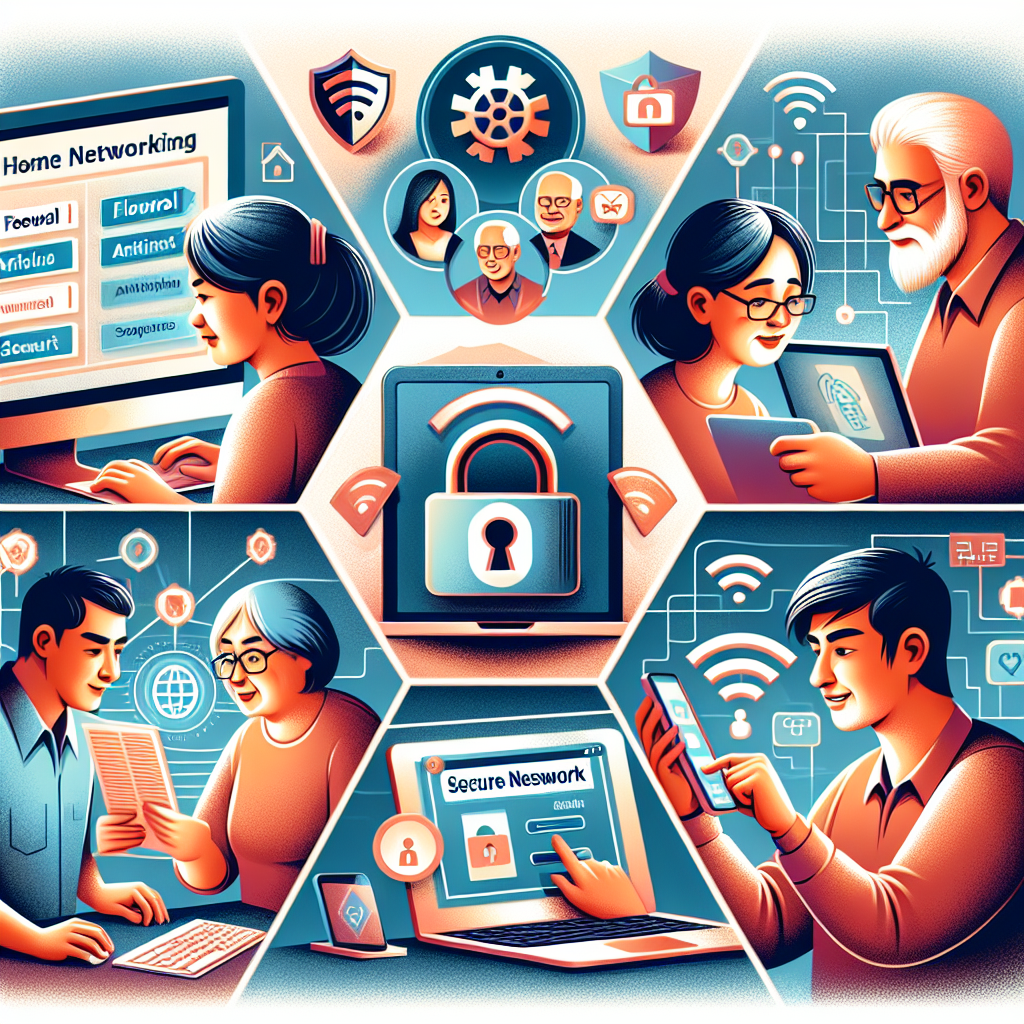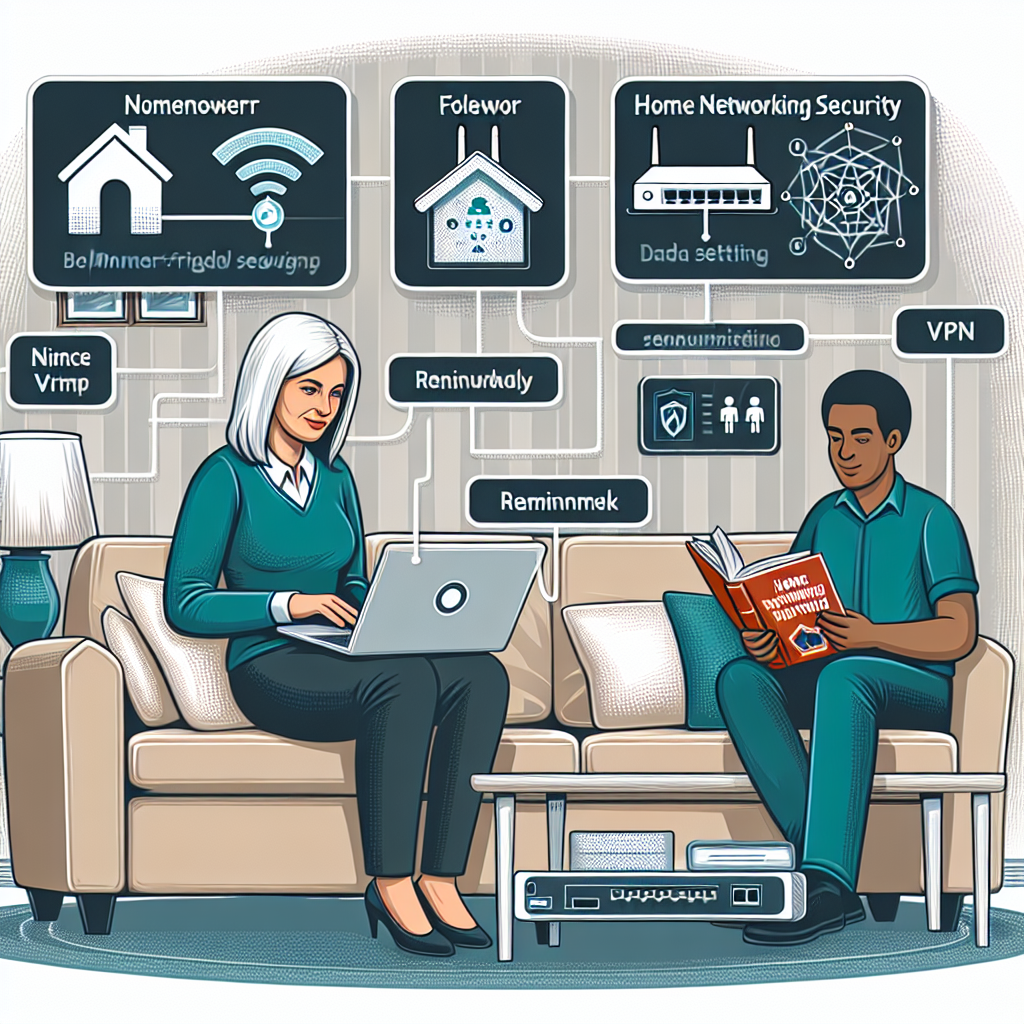In this day and age, our homes have become increasingly connected through technology, making home networking security more important than ever. Whether you’re new to the world of network security or just looking for some tips to enhance your current setup, this guide is for you. From securing your Wi-Fi network to protecting your personal information online, we’ll cover all the essential basics to keep your home network safe from cyber threats. By following these simple yet effective tips, you can ensure that your digital lives remain secure and worry-free.
Understanding Home Network Security

In today’s digital age, securing your home network is paramount to safeguarding your personal information and sensitive data from potential cyber threats. Understanding the basics of home network security is crucial for beginners to create a safe online environment for themselves and their families.
Importance of securing home networks
- Protecting personal information: Securing your home network helps prevent unauthorized access to personal data such as financial information, login credentials, and private communications.
- Preventing cyber attacks: A secure home network acts as a barrier against cybercriminals who may attempt to infiltrate your devices for malicious purposes.
- Ensuring privacy: By implementing security measures, you can maintain your privacy and avoid unauthorized surveillance or data breaches.
Common vulnerabilities in home networks
- Weak passwords: Using easily guessable passwords or not changing default passwords on devices can make your home network vulnerable to attacks.
- Outdated software: Failing to update software and firmware on routers and devices leaves them susceptible to known security flaws.
- Unsecured wireless networks: Not encrypting your Wi-Fi network or using outdated security protocols can expose your data to interception by unauthorized users.
Risks of not securing home networks
- Identity theft: Without proper security measures, cybercriminals can steal your identity and use it for fraudulent activities.
- Data breaches: Unsecured home networks can lead to data breaches where sensitive information is exposed or compromised.
- Malware infections: Lack of security can result in malware infections on your devices, leading to data loss, financial damage, or system malfunctions.

Basic Security Measures for Home Networks
Secure Your Wi-Fi Network
When it comes to securing your Wi-Fi network, there are several crucial steps that beginners should take to ensure the safety of their home network.
-
Change default network name (SSID) and password: One of the first things you should do when setting up your home Wi-Fi network is to change the default network name (SSID) and password. Default network names are often easily recognizable and can make it simpler for hackers to identify and target your network. By creating a unique SSID and a strong, complex password, you can significantly enhance the security of your network.
-
Enable network encryption (WPA3 or WPA2): Encryption is essential for safeguarding your network traffic from unauthorized access. Ensure that your Wi-Fi router is set to use the latest encryption standard available, such as WPA3 or WPA2. Encryption scrambles the data transmitted between your devices and router, making it challenging for hackers to intercept and decipher the information.
-
Disable network name broadcasting: Disabling network name broadcasting adds an extra layer of security to your Wi-Fi network. When broadcasting is turned off, your network’s name won’t be visible to devices scanning for available connections, making it more challenging for potential intruders to detect your network. While this may require manually entering the network name on trusted devices, it can significantly reduce the risk of unauthorized access.
Use Strong Passwords
When it comes to securing your home network, one of the fundamental steps is to ensure that you are using strong passwords for all your network devices. Weak passwords can be easily guessed or cracked by cybercriminals, putting your network and personal information at risk. Here are some key points to consider when creating and managing strong passwords:
- Importance of strong passwords for network devices:
- Strong passwords act as the first line of defense against unauthorized access to your network.
- They help prevent intruders from gaining control of your devices and stealing sensitive data.
-
A strong password can significantly enhance the overall security of your home network.
-
Tips for creating strong passwords:
- Use a combination of uppercase and lowercase letters, numbers, and special characters.
- Avoid using easily guessable information such as birthdays, names, or common words.
- Aim for a password that is at least 12-15 characters long to maximize complexity.
-
Consider creating a passphrase by stringing together multiple words to make it easier to remember but harder to crack.
-
Utilizing password managers:
- Password managers are tools that help you generate, store, and manage complex passwords for all your accounts.
- They can securely store your passwords and automatically fill them in when needed, reducing the risk of password reuse or forgetting passwords.
- By using a reputable password manager, you can enhance the security of your home network by ensuring that all your passwords are strong and unique.
Update Your Devices Regularly
-
Significance of updating firmware and software
Regularly updating the firmware and software on your devices is crucial for maintaining the security of your home network. These updates often contain patches for known security vulnerabilities that hackers can exploit to gain unauthorized access to your network or steal sensitive information. By staying up to date with the latest updates, you can effectively protect your devices and data from potential cyber threats. -
How updates patch security vulnerabilities
When you update your devices, you are essentially applying fixes that address security vulnerabilities identified by the device manufacturers or developers. Hackers are constantly looking for ways to exploit weaknesses in software and firmware to compromise devices and networks. By installing updates promptly, you are closing off these vulnerabilities and reducing the risk of being targeted by cyber attacks. -
Setting up automatic updates for devices

To ensure that your devices are always up to date with the latest security patches, it is recommended to enable automatic updates whenever possible. This feature allows your devices to download and install updates automatically, without requiring manual intervention. By enabling automatic updates, you can streamline the process of maintaining the security of your home network and minimize the risk of overlooking critical updates that could leave your devices vulnerable to cyber threats.
Implementing Network Segmentation
What is Network Segmentation?
Network segmentation refers to the practice of dividing a home network into smaller, distinct sections or segments to enhance security and control access within the network. This strategy involves creating barriers between different parts of the network to prevent unauthorized access and limit the potential impact of a security breach. By segmenting a home network, users can isolate sensitive devices or data from the rest of the network, thus reducing the risk of a single point of failure compromising the entire network.
Benefits of Network Segmentation:
– Enhanced Security: Network segmentation helps in containing security threats by restricting the movement of cyber threats across different segments of the network.
– Improved Performance: Segregating devices based on their functions can help optimize network performance by reducing congestion and enhancing network speed.
– Controlled Access: It enables users to control who can access specific parts of the network, enhancing privacy and data protection.
– Isolation of Vulnerable Devices: By isolating IoT devices or less secure gadgets into separate segments, users can prevent them from compromising more critical components of the network.
Different Ways to Segment a Home Network:
1. Physical Segmentation: Physically separating devices into different networks using separate routers or switches.
2. Virtual LANs (VLANs): Using VLANs to create logical segmentation within a single physical network infrastructure.
3. Subnetting: Dividing the network into subnets with unique IP addresses to control traffic flow and enhance security.
4. Access Control Lists (ACLs): Implementing ACLs on routers or firewalls to restrict traffic between different network segments based on predefined rules.
5. Guest Networks: Setting up a separate guest network for visitors to isolate their devices from the main home network.
Creating Guest Networks
Setting up a separate guest network:
– When setting up a guest network, ensure that it is physically separate from your main network to prevent unauthorized access to sensitive information.
– Guest networks can be created using your router’s settings by enabling a separate network SSID specifically for guests.
– Assign a unique password to the guest network to restrict access and protect your main network from potential security threats.
Benefits of guest networks for security:
– Guest networks provide an additional layer of security by isolating guest devices from your primary network, reducing the risk of malware or unauthorized access.
– Keeping guest devices on a separate network helps prevent them from interacting with your personal devices or IoT devices that may be connected to your main network.
How to secure guest networks effectively:
– Regularly update the password for your guest network to prevent unauthorized access, especially after hosting gatherings or visitors.
– Enable network encryption, such as WPA2, on the guest network to protect data transmitted between devices and the router.
– Consider setting time limits or bandwidth restrictions on the guest network to control usage and prevent potential abuse or security breaches.
Securing IoT Devices
Risks Associated with IoT Devices
IoT devices present a range of security risks that can compromise the overall security of a home network. It is crucial for beginners to understand these risks in order to effectively secure their IoT devices and protect their network from potential threats. Some key risks associated with IoT devices include:
- Vulnerabilities of IoT devices in home networks: IoT devices often have limited processing power and memory, making them susceptible to cyber attacks. Hackers can exploit vulnerabilities in these devices to gain unauthorized access to the network.
- Potential security threats from unsecured IoT devices: Unsecured IoT devices can serve as entry points for hackers to infiltrate the network and launch various attacks, such as malware infections, data breaches, and unauthorized surveillance.
- Importance of securing IoT devices: Securing IoT devices is critical to maintaining the overall security and privacy of the home network. By implementing security measures, such as changing default passwords, updating firmware regularly, and segmenting the network, beginners can mitigate the risks associated with IoT devices and safeguard their digital assets.
Best Practices for IoT Security
ng IoT Devices
IoT devices, or Internet of Things devices, have become increasingly popular in modern households, offering convenience and automation. However, these devices can also pose security risks if not properly secured. Implementing best practices for IoT security is crucial in safeguarding your home network from potential threats.
-
Changing default settings on IoT devices
- One of the first steps in securing IoT devices is to change the default settings that come pre-configured on the devices. Default settings are often generic and easily exploitable by hackers. By creating unique usernames and strong passwords, you can significantly reduce the risk of unauthorized access to your IoT devices.
-
Keeping IoT firmware up to date
- Manufacturers regularly release firmware updates to address security vulnerabilities and improve device performance. It is essential to keep your IoT devices’ firmware up to date by regularly checking for updates and installing them promptly. Outdated firmware can leave your devices susceptible to cyber attacks.
-
Using network segmentation for IoT devices
- Network segmentation involves creating separate networks for different types of devices to prevent potential security breaches from spreading across all devices. By placing your IoT devices on a separate network from your computers and smartphones, you can isolate any security incidents and protect your more sensitive data. Implementing network segmentation adds an extra layer of security to your home network and minimizes the impact of a potential breach on your IoT devices.
Monitoring and Managing Network Traffic
Network Monitoring Tools
Network monitoring tools are essential for beginners to ensure the security of their home networks. These tools offer a way to track and manage network traffic effectively, giving users insight into the devices connected to their network and the data being transmitted.
Introduction to Network Monitoring Tools
Network monitoring tools are software applications or hardware devices that allow users to observe and analyze the traffic on their network. These tools provide real-time data on network performance, bandwidth usage, and potential security threats. By monitoring network activity, users can identify any suspicious behavior or unauthorized access to their network.
How Monitoring Tools Enhance Network Security
Network monitoring tools play a crucial role in enhancing network security by providing visibility into network activity. They help users detect unusual patterns that may indicate a security breach, such as a high volume of data being sent to an unknown IP address. By monitoring network traffic, users can take proactive measures to protect their network from cyber threats and unauthorized access.
Recommended Network Monitoring Tools for Beginners
For beginners looking to improve their home network security, there are several user-friendly network monitoring tools available. Some popular options include:
- Wireshark: A widely-used network protocol analyzer that captures and displays network packets, allowing users to analyze traffic in detail.
- PRTG Network Monitor: A comprehensive network monitoring tool that offers a range of features, including bandwidth monitoring, alerting, and reporting.
- GlassWire: A visual network security tool that displays network activity in real-time and alerts users to potential threats or suspicious behavior.
By utilizing these recommended network monitoring tools, beginners can take proactive steps to secure their home network and prevent potential security risks.
Setting Up Parental Controls
- Importance of parental controls for network security
- Parents can restrict access to inappropriate content and websites for children.
- Helps in managing screen time and ensuring a healthy balance of online activities.
-
Prevents children from accidentally downloading malicious software or falling victim to online scams.
-
How parental controls help protect children online
- Filters out harmful or explicit content that children should not be exposed to.
- Limits the time spent online, promoting healthier habits and reducing the risk of internet addiction.
-
Allows parents to monitor and track their children’s online activities for safety and security purposes.
-
Configuring parental control settings on routers
- Access the router settings through a web browser using the default IP address provided by the manufacturer.
- Locate the parental control section within the router settings interface.
- Set up filters based on specific websites, keywords, or categories to block or restrict access.
- Establish time limits for internet usage or create schedules for when certain devices can connect to the network.
- Regularly review and adjust parental control settings as needed to ensure optimal protection for children online.
Educating Family Members on Cybersecurity
Importance of Cybersecurity Education
-
Preventing Cyber Threats: Cybersecurity education is crucial to safeguarding personal information and devices from cyber threats such as malware, phishing attacks, and data breaches.
-
Promoting Online Safety: By understanding cybersecurity best practices, family members can enhance their online safety and privacy, reducing the risk of falling victim to online scams or identity theft.
-
Securing Home Network: Educating family members on cybersecurity helps in securing the home network, ensuring that devices are protected from unauthorized access and potential intrusions.
-
Building Digital Literacy: Cybersecurity education fosters digital literacy among family members, empowering them to make informed decisions when using the internet and technology.
-
Creating a Culture of Security: By emphasizing the importance of cybersecurity, families can establish a culture of security where everyone plays a role in protecting the household’s digital assets and information.
FAQs Home Networking Security Tips for Beginners
Why is home networking security important?
Home networking security is important because it helps protect your personal and sensitive information from potential cyber threats. Without proper security measures in place, hackers could easily access your private data, such as financial information, passwords, and personal photos. By implementing security tips for your home network, you can ensure that your devices and data are protected.
What are some basic home networking security tips for beginners?
Some basic home networking security tips for beginners include changing the default login credentials for your router, enabling encryption on your Wi-Fi network, regularly updating your router’s firmware, enabling a firewall on your devices, and using strong, unique passwords for all your accounts. It’s also important to be cautious when clicking on links or downloading attachments from unknown sources, as they could contain malware that could compromise your network security.
How can I secure my Wi-Fi network?
To secure your Wi-Fi network, you should change the default SSID and password, enable WPA2 encryption, disable the SSID broadcast so your network isn’t visible to everyone, and limit the number of devices that can connect to your network. You should also regularly check for any unauthorized devices connected to your network and update your Wi-Fi password periodically to ensure security.
Why should I update my router’s firmware regularly?
Updating your router’s firmware regularly is important because manufacturers release updates that fix security vulnerabilities and improve the overall performance of your device. By keeping your router’s firmware up to date, you can ensure that your network is protected from the latest threats and that your devices are running smoothly. Failure to update your router’s firmware could leave your network vulnerable to cyber attacks.